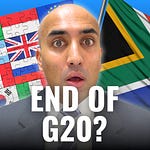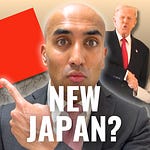I am excited to announce “Top 10,” a new way to look at geopolitics. Top 10 provides fresh, powerful, and actionable assessments of geopolitics, from blocs to technology, not available anywhere else. Join Mr. Geopolitics to access Top 10 along with dozens of other insights on world affairs from new business challenges to global rivalries to AI. Want a special introductory offer? Email me.
What is covered in today’s insight?
The top ten new geopolitical blocs
Their focus and impact on the world
Five key takeaways for leaders
The world is familiar with the G7 or G20. But, in the new global environment, these are not the only groupings or blocs. Many new ones have formed, with very clear agendas and objectives, from technology to sustainability.
These new blocs are are made up of nations who want to change the status quo, across multiple fronts. Alongside this, the new blocs signal that the world is turning “tribal” once again, as nations stand under flags, accelerating the new “vertical design” of the globe (full of walls and barriers).
As these blocs enter the spotlight, their actions could move the world onto new terrain. Below are the top ten new geopolitical blocs that could unleash dramatic change on the world.
Quicklist
BRICS+
GSI
AUKUS
Chip 4
ONEC
Lithium Triangle
I2U2
Asian Trilateral
Sahel Confederation
SQUAD
Longlist
1. BRICS+
FOCUS: GEOECONOMICS
In 2010, South Africa joined BRIC, making it BRICS. For over a decade, BRICS did not expand. But, at the BRICS Summit in August, 2023, all of this changed. The group invited six new countries (Argentina*, Egypt, Ethiopia, Iran, Saudi Arabia, and the UAE) expanding its footprint across the globe. As the global climate changes, the ideas that BRICS is proposing, like creating a BRICS currency, could split the global economy along new lines. BRICS represents the rise of “counter architecture” to what the West has built and offered. The big question in front of BRICS is whether it can convince other economies to adopt its ideas, and whether it can maintain its momentum as new internal challenges form like rival camps.
*Argentina ultimately rejected BRICS membership.
2. GSI
FOCUS: GEOPOLITICS
The Global Security Initiative (GSI), unveiled just a few months after the Ukraine war began, is a new project by China to lead the world in managing global security, from civil wars to regional conflicts. At its core, it is a Chinese equivalent to the United Nations, although this has not been explicitely mentioned. Unlike the Shanghai Cooperation Organization (SCO), formed by China and Russia in 2001, which has a huge mandate, the GSI is more concentrated and focused on making the world come to Beijing for resolving security tensions and problems with other nations. And in the process, putting China at the helm of helping governments solve disruptive events, not the US.
3. AUKUS
FOCUS: TECHNOLOGY, DEFENSE
The most significant geopolitical bloc that America has launched in decades, AUKUS is a technology-defense alliance between the US, UK, and Australia. It is a “new camp” within the Western camp, exclusively between Anglo-nations. When AUKUS was signed, countries like France and Germany were caught by surprise. For now, there are two parts of AUKUS, referred to as “Pillar 1” and “Pillar 2.” In Pillar 1, the US, UK, and Australia will build next-generation nuclear-powered submarines for Canberra. In Pillar 2, the focus will be on developing advanced technologies from AI to quantum. And, in Pillar 2, AUKUS may expand to include new countries like Canada and New Zealand. Unlike NATO, which is a military alliance, AUKUS is effectively an “R&D alliance”, a new kind of geopolitical bloc, that blurs the lines between defense and offense.
4. CHIP 4
FOCUS: TECHNOLOGY, TRADE
As fears grow about China’s chokehold on chip production, like with critical materials, along with a potential Chinese invasion of Taiwan, the West is trying to establish a separate technology ecosystem that can insulate the world from China’s geopolitics. Part of this is a new bloc between the US, Taiwan, Japan, and South Korea, called “Chip 4” to build brand new chip supply chains, from materials to production, that are completely “China free.” The goal of Chip 4 is to build a walled-off semiconductor world that only depends on Chip 4 nations and companies. While Chip 4 remains purely in the exploratory phase, it represents a radical new approach to blocs, where governments are designing their own “economies within economies” based on geopolitical lines.
5. ONEC
FOCUS: RESOURCES
By 2028, Indonesia will account for over 70% of global nickel production, up from more than 50% today. This critical metal, used in the production of batteries, was banned from being exported by Jakarta in 2020. Now, Indonesia is proposing a trade bloc for nickel exporters, nicknamed “ONEC (Organization of Nickel Exporting Countries).” The Indonesian government has already approached Australia and Canada to discuss their membership in bid to coordinate global production and supply of nickel. ONEC is significant for two reasons. First, in the new global climate, nations are approaching critical resources, beyond oil, gas, or fresh water, with a clear geopolitical agenda. Second, these nations are not global superpowers, but emerging powers, who are taking bold steps to grow their footprint.
6. LITHIUM TRIANGLE
FOCUS: RESOURCES
In South America, four countries are coming together around lithium. The Mexican government has proposed a new “alliance” with Argentina, Bolivia, and Chile, the latter three who represent the “lithium triangle,” where over 75% of the world’s lithium deposits are situated. From South America to Southeast Asia, the most critical metals, like lithium or nickel, required for sustainability, are all being eyed through a geoeconomic lens. As South American nations join hands around lithium, it could change how the rest of the world accesses lithium and drives their green initiatives. Just as countries like Zimbabwe and Ghana have banned the export of raw lithium, forcing companies to set up processing facilities domestically, spurring investment, so too the Lithium Triangle might do the same. Or like ONEC, the Lithium Triangle could begin to control the production and prices for lithium that disrupts the world.
7. I2U2
FOCUS: SUSTAINABILITY
The most unknown new geopolitical bloc, quietly formed towards the end of 2021, is called “I2U2,” which stands for Israel, India, the US, and the UAE. The core of I2U2 is green initiatives that revolve around technology. One of the projects I2U2 is working on will see the UAE invest $2 billion into green food parks in India. The US and Israel will provide private sector expertise and guidance for the project. I2U2 represents a new US-led push to take on China in the green world, as China’s green investments begin to pay off hugely. I2U2 integrates India into the US sphere of influence, and also establishes a new kind of American presence in the Middle East and Indo-Pacific. The group is following the same model of QUAD, where different members play different roles like financing or logistics.
8. Asian Trilateral
FOCUS: DEFENSE
In April, 2024, the leaders of the US, Japan, and the Philippines held their first summit at the White House. Their meeting revolved around security in the Indo-Pacific. But, it was really about the rise of a new informal bloc, a way to coordinate security in the South China Sea, in particular defending the Philippines from China. While there is no official name, beyond referring to the meeting as a trilateral grouping, it signals the rise of new US counter-blocs that will converge and diverge at different points, but will revolve around the same dynamic: the US and its “strongest partners” like Japan, South Korea, or Australia, supporting emerging powers in the Indo-Pacific, in this case the Philippines. It also signals that Japan is rapidly moving away from its pacifist doctrine and is playing a direct role in defense and security matters, changing the Japanese footprint in Asia.
9. Sahel Confederation
FOCUS: SECURITY
While the geopolitical spotlight has been on Europe, the Middle East, or US-China, a new bloc has formed in Africa. It is, amongst all the other new blocs, the newest. In July, three African nations joined hands to establish the “Alliance of Sahel States (AES)” made up of Niger, Burkina Faso, and Mali. At the core of AES is a new defense alliance between the three countries, building on a foundation established in September, 2023. However, AES is a rebuke of a separate geopolitical bloc in the region, the Economic Organization of West African States (ECOWAS), formed in 1975. After military coups, ECOWAS suspended the membership of Niger, Burkina Faso, and Mali, forcing these three nations to create their own “counter bloc.” This is the start regions being dominated by multiple blocs that are completely at-odds with one another.
10. SQUAD
FOCUS: DEFENSE
When the US defense secretary, Lloyd Austin, met with his counterparts from Australia, Japan, and the Philippines, in May, folks at the Pentagon referred to this meeting as “Squad.” It was a strange name, considering it was very similar to QUAD. The only difference between Squad and QUAD is that the US had swapped out India for the Philippines. Floating somewhere between Chip 4 (proposal stage) and AUKUS (execution stage), Squad represents a double-pivot by the US towards the Philippines - alongside the Asian Trilateral. But, alongside this, Squad gives America what it envisioned with Quad, but has been unable to manifest due to serious geopolitical differences with India. Which is to take bold steps to ensure China does not dominate the Indo-Pacific. Washington’s focus could increasingly drift towards Squad, and away from QUAD, as all four nations stand fully in the American corner and have no hangups taking a serious stance against China, or those in the Chinese corner, like Russia, who are trying to expand their footprint in Asia.
KEY TAKEAWAYS
US-CHINA CATALYST: The core of many of these blocs is the US-China fight. This fight is manifesting as bloc-competition, from US-led groupings to Chinese-led groupings. There are different paths. Organizations like Squad or the Asian Trilateral are being built to protect other nations from China. But, from Chip 4 to AUKUS, other blocs are being built to bolster Western power against China. A new era of bloc-based competition is beginning on the back of the US-China rivalry, which is not a New Cold War.
RESOURCE GEOECONOMICS: Governments are vieweing resources like nickel or lithium not just through the lens of development but also power. This is a new kind of geoeconomics around raw resources. In the current global climate, this kind of approach to resources further makes it clear that geopolitics is driving economics, not the other way around. The only other major resource bloc that has existed is OPEC. Soon, though, there could be several, each revolving around different critical resource, and each being led by a different power or group of powers.
SILOED TECH: Technology is redefining global power. And this is pushing countries to either build blocs that completely revolve around technology like Chip 4. Or it is pushing countries to expand the borders of their bloc to include technology like BRICS+. In either case, geopolitical blocs and technology now go hand-in-hand, changing everything from chips to AI is developed and deployed around the world. This could establish new barriers in the world. Chip 4 may be off limits to China, including the technologies it produces and exports. BRICS technologies, may be off limits to Western capitals. This will further drive a global vertical environment (i.e. a globe filled with barriers and walls on multiple fronts: ideological, economic, defense, technological, cultural, etc).
DISCARDING HISTORY: There was a time when being cast out from a bloc would cause that nation to rethink their position in order to regain entrance. But now, the opposite is happening. Nations that are being ejected from blocs are establishing their own blocs, almost overnight. There is no hesitation or hangup. And this means that old relationships and alliances are being discarded in the blink of an eye to make room for new geopolitical alignments. What nations had or shared means little anymore, as geopolitics quickly opens and closes doors.
NEW OUTLOOK: In the backdrop of today’s geopolitics, governments are changing their positions and outlooks. Nations who were once viewed as possible friends, even allies, are suddenly being viewed under dim light (i.e. India). And, countries that seemed to be moving away from friendship, are suddenly standing shoulder-to-shoulder (i.e. the Philippines). The new blocs that are forming represent the changing outlook of nations. And make it clear that geopolitics is not black-and-white, but rather deeply nuanced, and is quickly redesigning relationships and ties.
Want to republish this insight? Let’s talk: abishur@mrgeopolitics.com
If you liked this insight, why not invite your team?
Think somebody should read Mr. Geopolitics?











